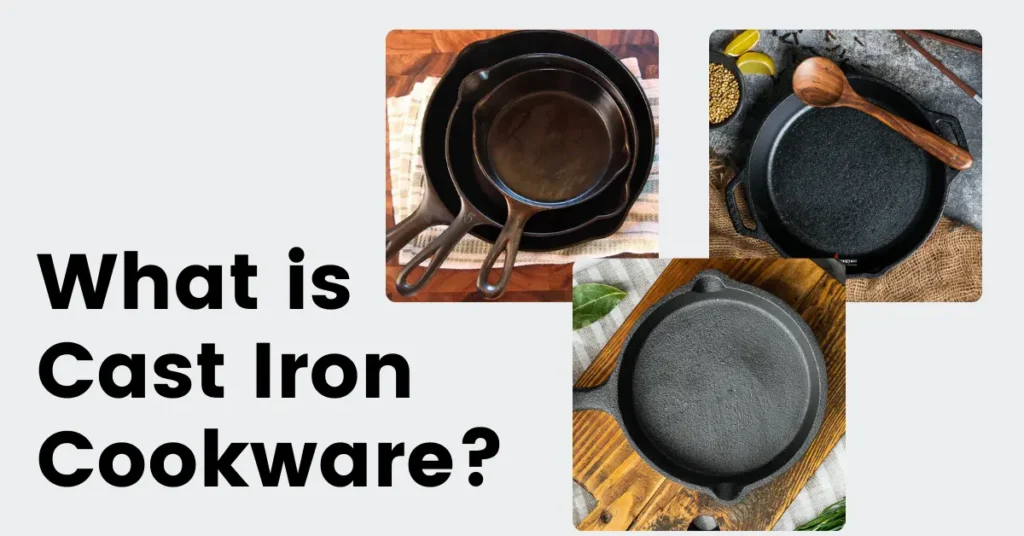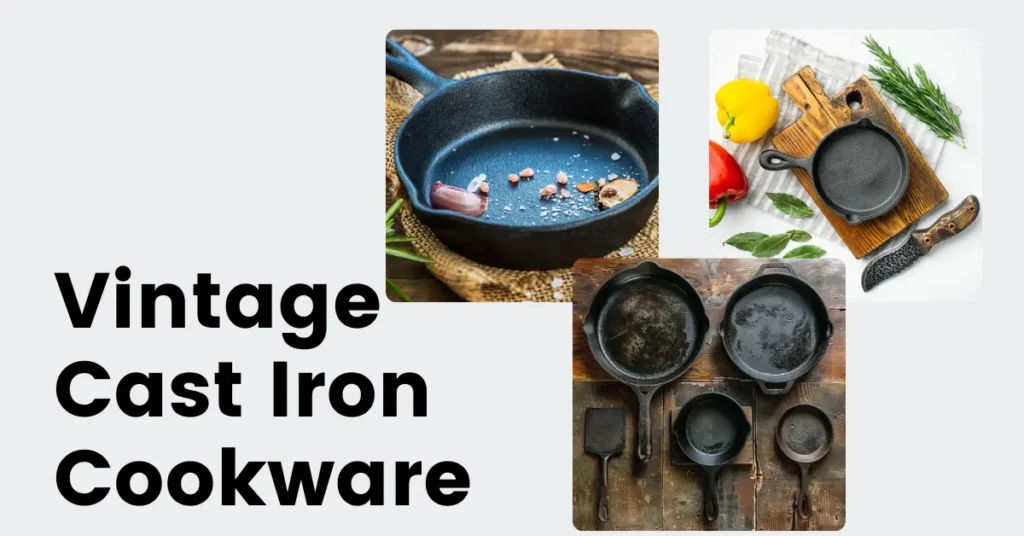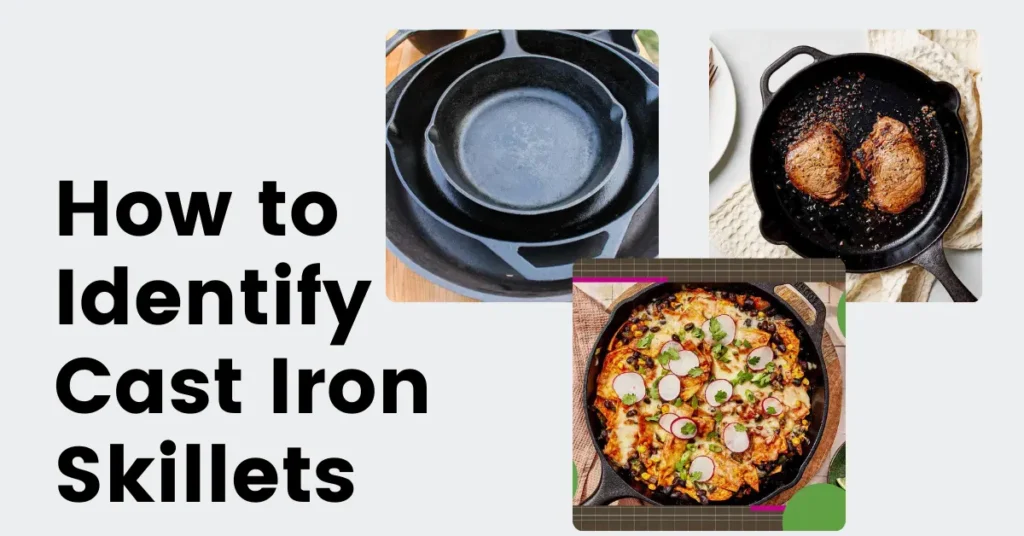The first time I saw a piece of cast iron cookware, I wasn’t sure if it was real or just an old pan. It looked heavy and solid, but how could I know for sure? If you’re just starting with cast iron, or if you’re a collector looking for vintage pieces, it’s important to know how to identify cast iron cookware.
In this article, I’ll show you how to tell if it’s cast iron, share tips for finding vintage skillets, and help you spot the real deal. By the end, you’ll feel confident in your ability to identify cast iron and enjoy using it in your kitchen.

What is Cast Iron Cookware?
Cast iron cookware is strong and built to last. You’ve probably seen heavy, solid pans or Dutch ovens in kitchens. They are made of cast iron, which holds heat well. This is why cast iron is so popular in kitchens around the world. It’s great for frying, baking, or simmering. The more you use it, the better it gets.
Cast iron cookware has some big benefits. It can last for years, sometimes even centuries. It works on all types of heat. Once seasoned, cast iron becomes non-stick. It also holds heat and cooks food evenly. Cast iron gives food a special flavor that other cookware can’t match.
There are many types of cast iron cookware. The most common is the skillet, perfect for frying and sautéing. Dutch ovens are great for slow cooking and baking. Griddles are good for pancakes and bacon. Grill pans are great for searing meat. Each piece serves a different purpose, making cast iron cookware a kitchen essential.
How to Identify Cast Iron Cookware
Identifying cast iron cookware is easier than it seems. You might pick up a pan and wonder if it’s the real deal. I’ve been there. The first time I held a cast iron skillet, I wasn’t sure if it was genuine or just an old, rusty pan. Over time, I learned how to tell the difference. Now, I’m going to share how you can do it, too.
Physical Characteristics
First, feel the weight. Cast iron is heavy. If the pan feels light, it’s probably not cast iron. A real cast iron piece feels solid and dense in your hand.
Next, check the surface. Cast iron can feel smooth or rough. Some pieces may be smoother, and others may be rougher. But don’t judge by texture alone. It’s the combination of features that will tell you if it’s cast iron.
Look at the color. Cast iron is usually dark—either black or grey. It can also have a shiny coating if it’s been used a lot. This is called a black patina. If the surface looks dull and raw, it’s not seasoned yet. Over time, it will change as you use it.
How to Test for Cast Iron
If you’re still not sure, you can try these tests.
- Magnet Test
A simple magnet will stick to cast iron. If it sticks, it’s probably cast iron. - Sound Test
Tap the pan with a spoon or your finger. Cast iron makes a unique, dull sound. Other metals sound sharper. - Heat Test
Cast iron holds heat longer than other metals. If the pan stays hot longer, it’s likely cast iron.
With these steps, you can easily tell if a pan is cast iron. Look at the weight, texture, and color. Do the magnet, sound, and heat tests. With time, you’ll get even better at spotting cast iron in your kitchen or at a store.

Identifying Vintage Cast Iron Cookware
Finding vintage cast iron cookware feels like discovering a hidden gem. I remember the first time I saw an old skillet at a flea market. It had a certain charm. But was it real cast iron? Was it valuable? I didn’t know. After doing some research, I learned what to look for in vintage pieces. Now, I can spot them easily.
Age Indicators
Start by checking for a foundry mark. Brands like Griswold, Wagner, and Lodge are known for their vintage cast iron. Griswold, especially, is famous for its beautiful designs. If you see their name or logo, you may have found a rare piece.
Next, think about the era and manufacturing techniques. Older pieces, made in the early 1900s, were made with more care. They often have thinner walls and smaller handles. These details can tell you a lot about its age.
Look for specific design features. Older skillets might not have pour spouts. Later models added them. You might also notice the handles are smaller, or the rims are thicker. These subtle features tell you when the piece was made.
Personal Experience
I remember the thrill of finding a Griswold skillet at a yard sale. I could tell it was special. It had that smooth surface and the Griswold logo on the bottom. It was old but not broken. The handle felt just right. I cleaned it up and started using it. Now, it’s one of my favorite skillets to cook with. I love knowing it has so much history.

How to Identify Cast Iron Skillets
Finding a cast iron skillet can feel like a small victory. I’ve picked up many over the years. Some were easy to identify, others, not so much. But over time, I learned the key signs. Let me share them with you.
Skillet-Specific Features
Handle Design and Shape
The handle of a cast iron skillet says a lot. Older skillets have long, narrow handles. They are thinner and feel easy to grip. When I found my first Griswold skillet, the handle was sleek and smooth. It felt balanced in my hand, just right for control. That handle told me it was special.
Pour Spouts
Look for pour spouts. These are useful for draining liquids. If your skillet has them, it’s likely newer. Older skillets don’t usually have pour spouts. So, if you find a skillet without them, it’s probably from an earlier time.
Flat or Curved Base
Now, check the base. Older skillets tend to have a slightly curved base. Newer ones are often flat. This curve is important. It helps heat spread evenly. Many vintage skillets have this feature, and it’s something I always look for now.
Popular Brands to Look For
Griswold, Wagner, and Lodge
When it comes to cast iron, Griswold, Wagner, and Lodge are the big names. These brands have a unique look. They also differ in value.
- Griswold skillets are smooth and have detailed designs. Look for the word “Erie” on the bottom. Griswold skillets are older, and collectors love them.
- Wagner skillets are a bit thicker. They are known for their durability and last for years.
- Lodge is the most common brand today. They’re easy to find and great for beginners. Lodge skillets have bold logos and are built to last.
Personal Story or Example
I’ll never forget the first Griswold skillet I found. It was at a small shop. The handle was thin, the surface smooth, and the logo faint. I wasn’t sure if it was special, but I took a chance. After cleaning it up, I saw how great it was. Now, it’s one of my favorite pans. Every time I cook with it, I think about its history.
Common Cast Iron Cookware Mistakes to Avoid
When I started using cast iron, I made mistakes. But, I learned quickly. Here are some tips to help you avoid them.
Missing Manufacturer Marks
I didn’t always check for marks on my cast iron. But these marks matter! They tell you who made the cookware. I found an old skillet once and almost skipped it. I didn’t see a mark at first. But later, I noticed a small Griswold logo on the bottom. That mark made it more valuable! Always look for the brand name or logo. It can tell you a lot about the skillet.
Ignoring the Condition of the Cookware
At first, I didn’t worry much about the condition. But rust, chips, and cracks matter! I bought a skillet with a small crack. At first, it worked fine. But over time, the crack made it heat unevenly. Now, I check for cracks and chips before buying. Rust can be cleaned off, but a crack? It’s a dealbreaker.
Not Seasoning Properly
Seasoning my cast iron was tricky at first. I didn’t do it right, and food stuck to the pan. But I learned! Now, I coat my skillet with a thin layer of oil. I bake it in the oven at 450°F for an hour. This process makes the pan non-stick. Seasoning is key to making cast iron last. It’s simple once you know how.
By following these tips, you’ll take better care of your cast iron. Always check the marks, inspect the condition, and don’t skip seasoning. These small steps will keep your cookware in great shape for years!
FAQs
How can I tell if my skillet is cast iron?
Cast iron is heavy. If your skillet is light, it’s not cast iron. Take a magnet. If it sticks, it’s cast iron. Cast iron also looks dark, usually black or gray. Over time, it becomes shiny from seasoning. That’s another sign.
How do I spot vintage cast iron cookware?
Look for brand marks. Popular brands like Griswold and Lodge often made old skillets. Griswold skillets have fine details. Some old skillets are thin with small handles. If it has these signs, it may be vintage.
Can I identify cast iron by weight?
Yes, weight matters. Cast iron is heavy. A 10-inch skillet weighs 5 to 6 pounds. If it feels light, it’s not cast iron.
Why is cast iron cookware so valuable?
Cast iron lasts a long time. It holds heat well and cooks food evenly. The flavor from cooking in cast iron is amazing. It also gets better the more you use it. Old skillets from brands like Griswold or Wagner are even more valuable.
Conclusion
Cast iron pans are easy to spot. They are heavy and dark. You can check with a magnet. If it sticks, it’s cast iron. I have used cast iron for years. I know the feel of a good skillet. It’s heavy. It’s rough. It heats well.
Old pans have marks. Look for brands like Griswold, Wagner, or Lodge. I’ve found a few vintage pans myself. The handle and shape can tell you how old it is. You can learn a lot from the small details.
Taking care of cast iron is important. Clean it well. Season it often. Dry it properly. If you treat it right, it will last forever. I have seen my pans last for decades. They only get better with time.
Next time you check a pan, think about its weight. Is it rough? Does it have a brand name? Try out the tips I shared. You might find something new. Do you have a favorite cast iron pan? Tell me about it in the comments.
For me, cast iron is not just for cooking. It connects me to the past. Every time I use a pan, I think about its long history. It has been used for so many years. With each meal, I feel part of that tradition.
With over 8 years of experience in the culinary and kitchen tools industry, I specializes in finding/reviewing high-performance cookware and innovative kitchen technology. My expert insights help both chefs and home cooks find efficient, user-friendly tools that enhance their cooking experience and elevate kitchen efficiency. More about Raimul…

